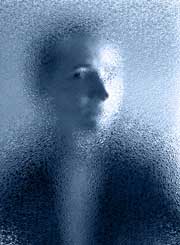24 July 2013
 A computational vision scientist at the University of South Australia has just published new research describing a key advance in our understanding of how the brain perceives the physical world.
A computational vision scientist at the University of South Australia has just published new research describing a key advance in our understanding of how the brain perceives the physical world.
"My research tries to account for everyday aspects of visual surface perception, like how we perceive frosted white glass, a glossy black car, or a brightly lit moon through grey cloud," says Dr Tony Vladusich, a Research Fellow in the Computational and Theoretical Neuroscience Laboratory at the University of South Australia’s Institute for Telecommunications Research (ITR).
"When we look at objects, we see that their surfaces vary in appearance in different ways, such as black to white, matte to glossy, and opaque to transparent," says Dr Vladusich.
"The way objects appear to us is partly based on how physical surfaces reflect and transmit light, and partly on the way the brain interprets the patterns of light reaching the eye. How the brain constructs our experience of different surface dimensions from these light patterns has long remained a mystery," he says.
In several articles published in the past year --- the latest appearing in the Journal of the Optical Society of America A --- Dr Vladusich introduced a new mathematical theory of how we perceive various surface dimensions, termed gamut relativity. The theory's name relates to the observation that the shades of black, grey or white that we experience on a surface, technically known as a ‘gamut’ depend on whether the surface is seen as opaque/transparent and matte/glossy.
"Traditional theories of vision suppose that the brain rather literally 'represents' the physical dimensions of surfaces, like building a miniature version of the world inside the brain.
“The new insight in the theory of gamut relativity is to show how brain computations can give rise to the experience of surfaces as varying along different physical dimensions, without literally representing those dimensions in the brain.
“Gamut relativity thus avoids some of the philosophical traps that have plagued conventional theories of vision, and in so doing solves many outstanding problems concerning how we see glossy and transparent surfaces.
"This theory could in future help in the design of engineered vision systems that will be able to classify objects and materials based only on their surface appearance. The theory thus offers new solutions to both deep philosophical conundrums and practical engineering problems”, says Dr Vladusich
ITR’s Computational and Theoretical Neuroscience research group leader Dr Mark McDonnell says the new insights are a significant advance in understanding how the human visual system represents information about surfaces.
"These insights will help guide our research into creating mathematical models and simulations of how the electrical activity of neurons in the brain supports the transformation of sensory information into perception,” says Dr McDonnell.
Contact for interviews: Dr Tony Vladusich on 0405270137 or Tony.Vladusic@unisa.edu.au




